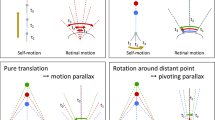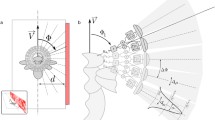Abstract
Behavioral experiments suggest that insects make use of the apparent image speed on their compound eyes to navigate through obstacles, control flight speed, land smoothly, and measure the distance they have flown. However, the vast majority of electrophysiological recordings from motion-sensitive insect neurons show responses which are tuned in spatial and temporal frequency and are thus unable to unambiguously represent image speed. We suggest that this contradiction may be resolved at an early stage of visual motion processing using nondirectional motion sensors that respond proportionally to image speed until their peak response. We describe and characterize a computational model of these sensors and propose a model by which a spatial collation of such sensors could be used to generate speed-dependent behavior.
Similar content being viewed by others
References
Barlow HB, Levick WR (1965) The mechanism of directionally selective units in rabbit’s retina. J Physiol Lond 178:477–504
Buschbeck EK, Strausfeld NJ (1996) Visual motion-detection circuits in flies: small field retinotopic elements responding to motion are evolutionarily conserved across taxa. J Neurosci 16:4563–4578
David CT (1982) Compensation for height in the control of groundspeed by Drosophila in a new, ‘Barber’s Pole’ wind tunnel. J Comp Physiol A 147:485–493
Douglass JK, Strausfeld NJ (1995) Visual motion detection circuits in flies: peripheral motion computation by identified small field retinotopic neurons. J Neurosci 15:5596–5611
Douglass JK, Strausfeld NJ (1996) Visual motion detection circuits in flies: parallel direction- and non-direction sensitive pathways between the medulla and lobula plate. J Neurosci 16:4551–4562
Dror RO, O’Carroll DC, Laughlin SB (2001) Accuracy of velocity estimation by Reichardt correlators. J Opt Soc Am A 18(2):241–252
Egelhaaf M, Borst A (1989) Transient and steady-state response properties of movement detectors. J Opt Soc Am A 6:116–127
Grzywacz NM, Yuille AL (1990) A model for the estimate of local image velocity by cells in the visual cortex. Proc R Soc Lond B Biol Sci 239:129–161
Hassenstein B, Reichardt W (1956) Systemtheorische analyse der Zeit-, Reihenfolgen- und Vorzeichenauswertung bei der Bewegungsperzeption des Rüsselkäfers Chlorophanus. Zeitschrift für Naturforschung 11b:513–524
Hausen K (1982) Motion sensitive interneurons in the optomotor system of the fly. I. The horizontal cells: structure and signals. Biol Cybern 45:143–156
Hausen K, Egelhaaf M (1989) Neural mechanisms of visual course control in insects. In: Stavenga DG, Hardie RC (eds) Facets of vision, Chap 18. Springer, Berlin Heidelberg New York, pp 391–424
Higgins CM, Douglass JK, Strausfeld NJ (2004) The computational basis of an identified neuronal circuit for elementary motion detection in dipterous insects. Vis Neurosci 21
Ibbotson MR (1991) A motion-sensitive visual descending neurone in Apis mellifera monitoring translatory flow-fields in the horizontal plane. J Exp Biol 157:573–577
Kirchner WH, Srinivasan MV (1989) Freely flying honeybees use image motion to estimate object distance. Naturwissenschaften 76:281–282
Nakayama K (1985) Biological image motion processing: a review. Vis Res 25:625–660
Osorio D (1991) Mechanisms of early visual processing in the medulla of the locust optic lobe: How self-inhibition, spatial-pooling, and signal rectification contribute to the properties of transient cells. Vis Neurosci 7:345–355
Snyder AW (1979) Physics of vision in compound eyes. In: Autrum H (ed) Comparative physiology and evolution of vision in invertebrates: invertebrate photoreceptors, vol VII/6A of Handbook of sensory physiology, Chap 5. Springer, Berlin Heidelberg New York, pp 225–313
Srinivasan MV, Lehrer M, Kirchner WH, Zhang SW (1991) Range perception through apparent image speed in freely-flying honeybees. Vis Neurosci 6:519–535
Srinivasan MV, Zhang SW (1993) Evidence for two distinct movement-detecting mechanisms in insect vision. Naturwissenschaften 80:38–41
Srinivasan MV, Zhang SW, Chahl JS, Barth E, Venkatesh S (2000) How honeybees make grazing landings on flat surfaces. Biol Cybern 83:171–183
Srinivasan MV, Zhang SW, Lehrer M, Collett TS (1996) Honeybee navigation en route to the goal: visual flight control and odometry. J Exp Biol 199:237–244
Van Santen JPH, Sperling G (1985) Elaborated Reichardt detectors. J Opt Soc Am A 2:300–320
Zanker JM, Srinivasan MV, Egelhaaf M (1999) Speed tuning in elementary motion detectors of the correlation type. Biol Cybern 80:109–116
Author information
Authors and Affiliations
Corresponding author
Additional information
Acknowledgements A major portion of this work was carried out during the tenure of a Centre for Visual Sciences Visiting Fellowship at the Australian National University. The author would like to gratefully acknowledge the advice and comments of Mandyam V. Srinivasan and Michael Ibbotson of ANU.
Rights and permissions
About this article
Cite this article
Higgins, C. Nondirectional motion may underlie insect behavioral dependence on image speed. Biol. Cybern. 91, 326–332 (2004). https://doi.org/10.1007/s00422-004-0519-x
Received:
Accepted:
Published:
Issue Date:
DOI: https://doi.org/10.1007/s00422-004-0519-x




